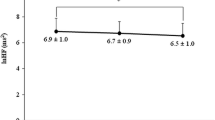Summary
The influence of diving and breath-hold following different levels of exercise on the changes of heart rate was investigated in male humans. The subjects had to swim against variable forces, until their heart rate had reached mean values of 80, 100, 120, and 140 beats min−1. 5–10 sec, after diving had started, the heart rate began to decrease and reached values of 50–60 min−1 which were independent from the starting level. The corresponding values recorded during breath-hold in water without diving were found to be about 20% higher. About 20 sec after the end of diving or breath-hold the heart rate was 10–20% lower than its starting level.
It is discussed that the effect is due to an isolated augmentation of vagal tone on the heart which is elicited from stretch receptors of the right heart and the pulmonary trunk. The threshold of these receptors seems to be exceeded by the combined pressure effects of immersion and inspiration on the central blood volume.
The “diving reflex” in man generally seems to be an effect of a general augmentation of sympathetic tonus caused by the preliminary exercise or oxygen lack combined with an isolated increase in the heart vagal tonus.
Zusammenfassung
Der Einfluß von Tauchen und Atemanhalten auf die Herzfrequenz wurde nach unterschiedlicher Anstrengung an männlichen Versuchspersonen untersucht. Um die Belastung zu dosieren, schwammen sie gegen unterschiedliche Krärte, bis ihre Herzfrequenz 80, 100, 120, 140 Schläge min−1 erreicht hatte. 5–10 sec nach Tauchbeginn fiel die Herzfrequenz ab und erreichte Frequenzen von 50–60 min−1, die unabhängig von den Ausgangswerten waren. Die entsprechenden Werte beim Atemanhalten im Wasser waren etwa 20% höher. Ungefähr 20 sec nach dem Ende des Tauchens und Atemanhaltens erreichte die Herzfrequenz ein Niveau, das 10–20% unter dem Ausgangswert lag.
Die Effekte werden auf eine isolierte Erhöhung des Vagustonus des Herzens zurückgeführt, der von Dehnungsreceptoren des rechten Herzens und des Truncus arteriosus ausgeht. Die Schwelle dieser Receptoren scheint durch die kombinierte Wirkung der Immersion und der Inspiration auf das zentrale Blutvolumen überschritten zu werden.
Der “Tauchreflex” scheint also beim Menschen aus einer generalisierten Erhöhung des Sympathicustonus, der durch die vorausgegangene Arbeit oder den Sauerstoffmangel ausgelöst wird, verbunden mit einer isolierten Steigerung des Vagustonus des Herzens zu bestehen.
Similar content being viewed by others
Literatur
Agostoni, E.: In Physiology of breath-hold diving and the ama of Japan, ed. byH. Rahn andT. Yokoyama: Washington D.C.: National Research Council 1965.
Anderson, H. T.: Physiological adaptations in diving animals. Physiol. Rev.46, 212 (1966).
Asmussen, E., andN. G. Kristiansson: The diving bradycardia in exercising man. Acta physiol. scand.73, 527 (1968).
Barber, G. R., u.S. R. Kottegoda: zit. nachKramer. Verh. dtsch. Ges. Kreisl.-Forsch.25, 155 (1959).
Craig, A. B., Jr.: Heart Rate response to apneic underwater diving and to breath holding in man. J. appl. Physiol.18, 854 (1963).
Elsner, R., andP. F. Scholander: In Physiology of breath-hold diving and the ama of Japan, ed. byH. Rahn andT. Yokoyama. Washington, D.C.: National Research Council 1965
Harding, P. E., D. Roman, andR. F. Whelan: Diving bradycardia in man. J. Physiol. (Lond.)181, 401 (1965).
Harrison, R. J., andJ. D. W. Tomlinson: Normal and experimental diving in the common seal (Phoca vitulina). Extrait de Mammalia24, 386 (1960).
Irving, L.: Respiration in diving mammals. Physiol. Rev.19, 112 (1939).
— Bradycardia in human divers. J. appl. Physiol.18, 489 (1963).
Kramer, K.: Die afferente Innervation und die Reflexe von Herz und venösem System. Verh. dtsch. Ges. Kreisl.-Forsch.25, 142 (1959).
Leivestad, H., H. Andersen, andP. F. Scholander: Physiological response to air exposure in codfish. Science126, 505 (1957).
Murdaugh, H. V., Jr., B. Schmidt-Nielsen, J. W. Wood, andW. L. Mitchell: Cessation of renal function during diving in the trained seal (Phoca vitulina). J. cell. comp. Physiol.58, 261 (1961).
Olsen, C. R., D. D. Fanestil, andP. F. Scholander: Some effects of apneic underwater diving on blood gases, lactate and pressure in man. J. appl. Physiol.17, 938 (1962).
Rahn, H.: In Physiology of breath-hold diving and the Ama of Japan. ed. byH. Rahn andT. Yokoyama. Washington D.C.: National Research Council 1965.
Scholander, P. F.: Experimental investigations on the respiratory function in diving mammals and birds. Hvalradets Skrifter Norske Videnskaps-Akad. Oslo22, 131 (1940).
—: Animals in aquatic environments: diving mammals and birds. In Handbook of Physiology. Adaptation to the environment, ed. byD. B. Dill, E. F. Adolph, andC. G. Wilber. Washington D.C.: American Physiological Society 1964.
—, andS. W. Grinnell: The respiration of the porpoise, Tursiops truncatus. J. cell. comp. Physiol.135, 557 (1942).
Sjöstrand, T.: Volume and Distribution of blood and their significance in regulation the circulation. J. app. Physiol.17, 519 (1962).
Stegemann, J., u.U. Tibes: Der Einfluß von Amplitude, Frequenz und Mittelwert sinusförmiger Reizdrucke an den Pressoreceptoren auf den arteriellen Mitteldruck des Hundes. Pflügers Arch.305, 219 (1969).
Strauss E.: Die Bedeutung der Druckamplitude und des Herzreflexes für die reflektorische Selbststeuerung des Kreislaufes. Arch. Kreisl.-Forsch.6, 65 (1940).
Author information
Authors and Affiliations
Rights and permissions
About this article
Cite this article
Stegemann, J., Tibes, U. Die Veränderung der Herzfrequenz beim Tauchen und Atemanhalten nach körperlicher Anstrengung. Pflugers Arch. 308, 16–24 (1969). https://doi.org/10.1007/BF00588030
Received:
Issue Date:
DOI: https://doi.org/10.1007/BF00588030




